More Than a Copy
A Closer Look at John Smith's 1612 Susquehannock Warrior
By Jessica Diemer-Eaton
Originally published in the May/June 2013 issue of Journal of the Early Americas (the author, J. Diemer-Eaton, holds the right to publish the same article here)
|
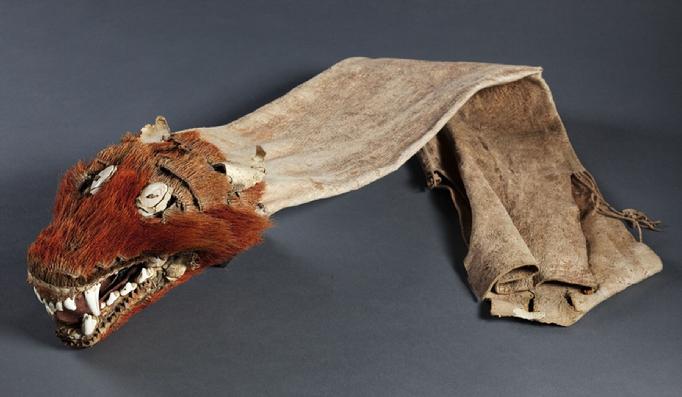 |
| Wolf head quiver (with canine skull, and formed skin/hide made with dyed deer hair, shells for eyes, and formed and attached ears) from the New Sweden Collection. |
|
|
Reported to be the first European to come in contact with the Susquehannock in the seventeenth-century Chesapeake, John Smith took a particular interest in their culture, and their appearance. One such rendering of a Susquehannock man appeared on John Smith’s 1612 map.[i] Of particular interest to those utilizing Smith’s accounts and published illustrations while researching Native dress, this Susquehannock figure wears a fitted mantle or shirt-like garment consisting of furs (possibly made of medium to large mammal faces) and trimmed at certain points with animal paws (possibly hanging from the noses of the face-hides). Some wonder if this shirt should be taken seriously - there exists a question of the originality of the illustration on Smith’s map, engraved by William Hole, a man who lacked first-hand knowledge of America’s Native Peoples. Copy or no, the Susquehannock man from Smith and Hole, offers invaluable insight into this influential tribe of the tidewater Chesapeake and eastern Indian dress.
[i] Captain John Smith’s Map of Virginia, 1612 http://www.virtualjamestown.org/jsmap_large.html [accessed January 10, 2013].
|
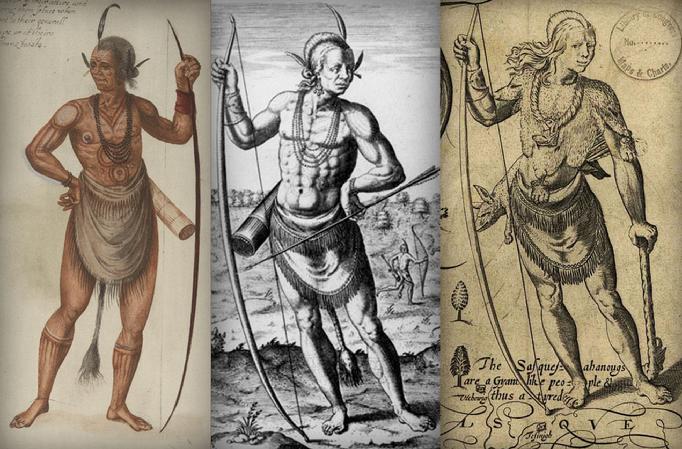 |
| Left: White's depiction of a Virginia/Carolina Native man. Middle: De Bry's engraving of the same Virginia/Carolina man. Right: Susquehannock figure on Smith's 1612 map. |
|
|
The image of a Native Susquehannock man featured on the John Smith map is not as distinctive or original as one would hope. In reality, this imagery is a rendition of Theodore de Bry’s warrior of 1590, which is in turn a copy of John White’s watercolor of a Virginia warrior from 1585.”[i] Although by first glance, one would easily point out the latter two, De Bry’s rendition and the Smith map warrior image, as obviously the same, it is only with closer inspection that we see the similarity in cultural material is truly stronger with the first two, White and De Bry’s illustrations.
It was actually Smith’s map that broke away from the originals, changing the quiver from a possible reed/plant material quiver to an animal hide quiver, removing the knot from his hair and adding height to the crown’s shorter hairs, and adding a distinctive canine-head pendant, animal fur and paw mantle/shirt over his chest, and a war club in his hand opposite his bow. Were these changes arbitrary and possibly based more on artistic license, or should we take the Smith map rendering seriously as historic evidence of Native dress and accessories?
[i] Brendan Wolfe, “Map of the Day” on Encyclopedia Virginia. November 6, 2012, http://blog.encyclopediavirginia.org/2012/11/06/map-of-the-day-5/ [accessed December 13, 2012].
|
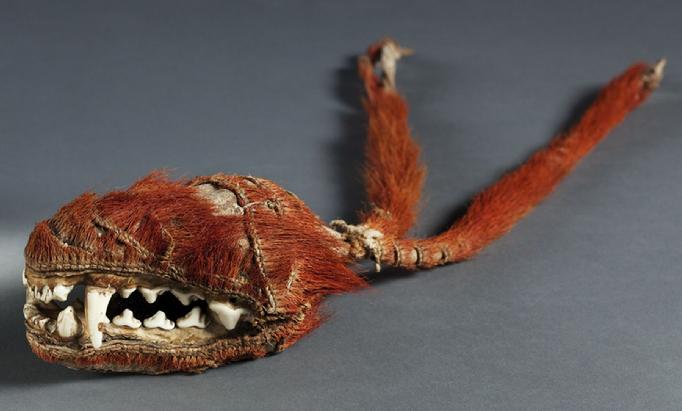 |
| Wolf head pendant (with canine skull decorated with dyed deer hair) from the New Sweden Collection |
|
|
The fur shirt, quiver, and canine-head pendant may be more correct than fanciful. By the 1630s colonists of New Sweden (modern-day south New Jersey and Delaware) collected, among other pieces, a stuffed wolf head pendant (wolf skull covered with padded buckskin) on a thick necklace of orange-red dyed deer fur and a wolf-head quiver. [i] These pieces are oddly similar to what is illustrated on the warrior on the Smith map, down to the fur-wrapped strap of the pendent. It is worth noting that the animal’s features on both the collected necklace pendant and quiver are embellished, for example, the wolf face on the quiver is detailed with mussel shell eyes and artificial ears. This offers credence to the detail of paws and claws that dangle from the fur shirt Hole depicts the Susquehannock warrior wearing on the Smith map. [ii]
[i] Herbert C. Kraft, The Lenape-Delaware Indian Heritage: 10,000BC – AD2000 (Stanhope, N.J.: Lenape Books, 2001), 235. New Sweden Colony existed around the Delaware Bay area from 1638 to 1655, overtaken by the Dutch and by 1664, the English. The New Sweden Colony Collection is currently on display at Skokloster Castle, in Skokloster, Sweden, and may be viewed online at http://emuseumplus.lsh.se/eMuseumPlus?service=direct/1/ResultDetailView/result.t1.collection_detail.$TspReferenceLink.link&sp=10&sp=Scollection&sp=SfieldValue&sp=0&sp=3&sp=3&sp=SdetailView&sp=435&sp=Sdetail&sp=0&sp=F&sp=Sartist&sp=l24179#
[ii] Herbert C. Kraft, The Lenape-Delaware Indian Heritage: 10,000BC – AD2000 (Stanhope, N.J.: Lenape Books, 2001). Of the Susquehannnock warrior in the Smith map: “The Indian wears a canine head pendent that is suspended from a hair- or fur-wrapped neck band, and a wolf’s head quiver across his back… much like the items (239)” collected from the New Sweden Colony. And, “The head is formed with stuffed buckskin ornamented with artificial ears of leather and eyes made of mussel shells (238).”
|
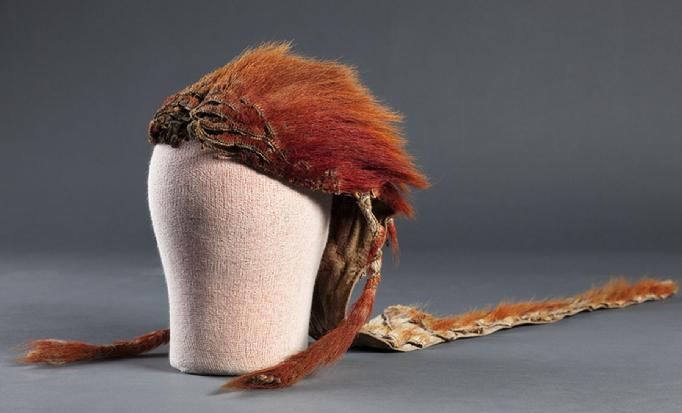 |
| Roach-style headress fromt he New Sweden collection |
|
|
John White’s 1585 watercolor depicted a Virginia chief with a haircut that featured short stubble hair on top on one side of his head with a section of long hair in a knot, however, the 1612 Smith map’s Susquehannock sports free-flowing hair with possibly longer vertical hairs on top of the crown, or, possibly a headpiece or headdress known as a roach. The New Sweden colony also collected an orange-red dyed deer hair headdress that extended long-ways from the crown of the head down at a length of 25.5 inches. Such a roach design is usually thought to be a later style, but this and other pieces suggest it was one of the first roach styles collected of eastern Natives in the mid-seventeenth century. [i]
[i] Ibid., 236. “…back flap extending down for a length of 25.5 inches.” Popular thought holds that this long roach style is unknown before the nineteenth century among Eastern Woodland tribes, and is attributed to influence of Plains tribes during and after the removal period.
|
 |
| Other artifacts collected by New Sweden: Dyed deer hair "fur rope" necklace. |
|
|
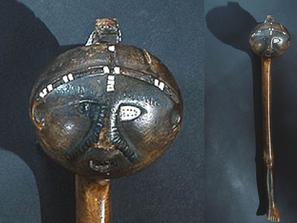 |
| Other artifacts collected by New Sweden: war club featuring human face, knee, and foot. |
|
|
More complex are the headdress, wolf pendant, and wolf quiver artifacts, along with two ball-headed war clubs (such as the one that appears in the warrior’s hand) were collected sometime after 1637 over two decades after John Smith’s 1612 map and in New Sweden rather than Virginia.[i] These artifacts were not at the disposal of Smith nor Hole. The accuracy of eastern Native clothing styles had been conveyed to Hole – not all was a copy or fanciful art. A similar upper garment appears in the later 1657 Jesuit map Novae Franciae Accurata Delineatio by Francesco-Giuseppe Bressani (as he served in the field).[ii] His depiction of the garment is looser-fitting and lacks detail of animal faces or paws, most likely because this is no copy but another first-hand observation of a similar garment. Bressani’s illustrations were more likely original in nature and done from memory, and reliable - the illustration at the upper corner of his 1657 map also features the same man wearing a well-known style of pouch over his fur mantle, and the woman kneeling next to him wears the bow-tie-shaped hair piece, a hide skirt (or one-piece tube-dress bottom), and what appears to be detachable sleeves – all considered very accurate.[iii]
Given the similarities between the John White watercolor and the John Smith imagery, one could discount his illustration as nothing more than just a copy. The extreme similarities between the Smith’s 1612 map image and the New Sweden collection offer something more. The artist commissioned to create Smith’s map merely consulted a prior image as a jumping-off point, and where the costume needed to differ to reflect contemporary descriptions of Virginia Natives, the artist was obliged to comply. We should consider the fur shirt he illustrates, trimmed with paws, as real along with the pendant and quiver depicted alongside it. The warrior figure along with the seventeenth-century New Sweden Colony collection offer proof that those historic depictions labeled as merely fanciful or regarded as just copies should be examined more thoughtfully. The complex image of early America that emerges illustrates similar yet distinct eastern woodland Indian cultures, networks of European explorers and their artists, and the understanding and confusion that lay in between.
[i] Herbert C. Kraft, The Lenape-Delaware Indian Heritage: 10,000BC – AD2000 (Stanhope, N.J.: Lenape Books, 2001), 236; Eric D.J. Törnqvist, “Johan Printz,” The Swedish Colonial Society http://www.colonialswedes.org/Forefathers/Printz.html [accessed December 5, 2012] originally published in Swedish Colonial News 1.7 (Spring 1993). Skokloster Castle lists the dates of the artifacts as generally between 1600 and 1650. The New Sweden Colony, which these pieces are attributed to, was established in 1638. The donor listed by Skokloster Castle is Johan Printz. Johan Björnsson Printz served as governor of New Sweden from 1643 to 1653 demonstrating that the New Sweden Colony Collection dates at least thirty years after the 1612 Smith map and yet offers invaluable clues to understanding it.
[ii] Charles George Herbermann, Catholic Encyclopedia, Vol. II (New York: The Encyclopedia Press, 1913), 766. “On his arrival in America he was assigned to the spiritual care of the French at Quebec, but in the following year was sent to the Algonquins at Three Rivers. In April, 1644, on the way to the Huron Mission he was captured by the Iroquois and cruelly tortured by them, at intervals, for over two months. He was at length ransomed by the Dutch at Fort Orange, and sent to France, where he arrived in November, 1644. In the following year he was again in Canada and labored zealously on the Huron Mission until its destruction by the Iroquois four years later. He continued, however, to minister to the scattered and fugitive Hurons.”
[iii] Franceso Bressani, Nova Francia acurata delineatio (western sheet), 1657 at SUNY Stonybrook Library http://www.stonybrook.edu/libmap/Bressani.htm [accessed December 13, 2012]. “The iconography of this map is also remarkable. It contains a number of accurate drawings of American Indians going about their daily activities, including a Canadian Algonkian hunting a moose on snowshoes, and women preparing food and tending children. It is also a brilliant example of a propaganda map. The "barbarous" activities of unconverted Indians are contrasted with they image of praying Indians at the upper-left corner of the map. The map thus makes a powerful appeal for support of the Jesuit missions.” In this particular case, the propaganda art should have little effect on the accuracy of the clothing. In fact, it may be the reason he was one of the few to document full outfits and not just half-naked Native dress in all seasons, as “fully clothed” Natives (in clearly non-European garb) made for a better showing for Christianity in the New World. Well-clothed Natives conveyed “civilized” peoples, while less dress likened the Natives to “children of nature” which was “exotic” and popular in European culture.
|
Note on the quiver: It should be noted that the quiver in question (collected by the New Sweden Colony) has in the past been labeled a possible headdress. This was proposed by Stig Ryden in 1963, when he theorized the quiver’s wolf head was strapped to the top of the wearer’s head, with the roach-like headdress covering the bear skin body of the quiver, and the small wolf head pendant trailing behind on the wearer’s back, attached to the ends of these “headdresses” (such an arrangement can be seen also in the Men-at-Arms series book "Indian Tribes of the New England Frontier" page 28, plate D). This was considered by Dr. Herbert Kraft to be very improbably, and he drew a different conclusion based on the Smith map figure (where the wolf head “quiver” was a quiver, and the small wolf head pendant an actual necklace worn in front). For info on Dr. Kraft’s decription and interpretation of the artifacts collected by the New Sweden Colony, please refer to “Lenape and/or Susquhannock Treasures in Skokloster Castle, Sweden” in the “Bulletin of the Archaeological Society of New Jersey, No. 50,” 1995.
Note on photos: Collection photos listed as public domain by Skokloster Castle. A special thanks to Skokloster Castle for helping to direct me to the collection pics I needed along with answering questions concerning the rights of use (and translating such). White, De Bry and Smith (map) illustrations obtianed from Wikipedia Commons and listed public domian.
|
|